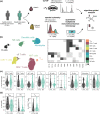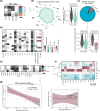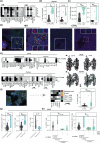Single-cell profiling of myasthenia gravis identifies a pathogenic T cell signature
- PMID: 33774709
- PMCID: PMC8113175
- DOI: 10.1007/s00401-021-02299-y
Single-cell profiling of myasthenia gravis identifies a pathogenic T cell signature
Erratum in
-
Correction to: Single‑cell profiling of myasthenia gravis identifies a pathogenic T cell signature.Acta Neuropathol. 2021 Oct;142(4):789. doi: 10.1007/s00401-021-02359-3. Acta Neuropathol. 2021. PMID: 34406497 Free PMC article. No abstract available.
Abstract
Myasthenia gravis (MG) is an autoimmune disease characterized by impaired neuromuscular signaling due to autoantibodies targeting the acetylcholine receptor. Although its auto-antigens and effector mechanisms are well defined, the cellular and molecular drivers underpinning MG remain elusive. Here, we employed high-dimensional single-cell mass and spectral cytometry of blood and thymus samples from MG patients in combination with supervised and unsupervised machine-learning tools to gain insight into the immune dysregulation underlying MG. By creating a comprehensive immune map, we identified two dysregulated subsets of inflammatory circulating memory T helper (Th) cells. These signature ThCD103 and ThGM cells populated the diseased thymus, were reduced in the blood of MG patients, and were inversely correlated with disease severity. Both signature Th subsets rebounded in the blood of MG patients after surgical thymus removal, indicative of their role as cellular markers of disease activity. Together, this in-depth analysis of the immune landscape of MG provides valuable insight into disease pathogenesis, suggests novel biomarkers and identifies new potential therapeutic targets for treatment.
Keywords: Autoimmunity; Biomarker; Cytokines; Immunophenotyping; Mass cytometry; Myasthenia gravis; Thymus; Tissue-resident T cells.
Conflict of interest statement
The authors declare no competing interests.
Figures




References
-
- Benjamini Y, Hochberg Y. Controlling the false discovery rate: a practical and powerful approach to multiple testing. J R Stat Soc Ser B. 1995 doi: 10.1111/j.2517-6161.1995.tb02031.x. - DOI
Publication types
MeSH terms
Substances
Grants and funding
LinkOut - more resources
Full Text Sources
Other Literature Sources
Medical
Research Materials

